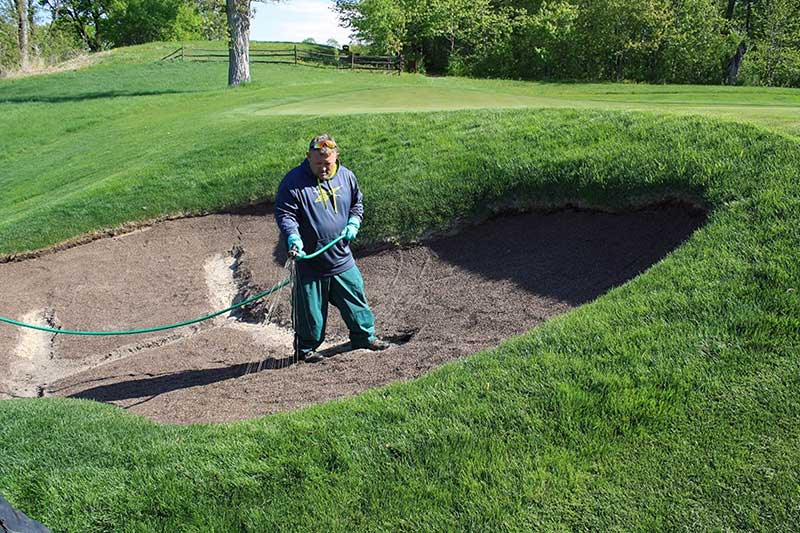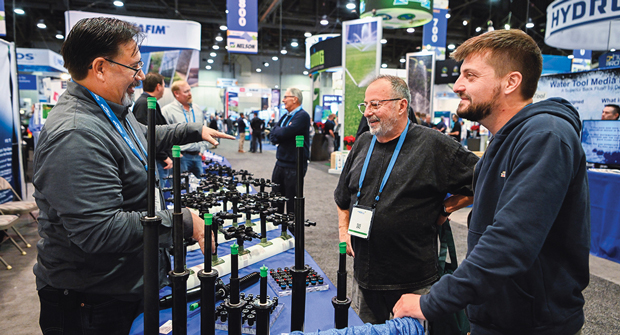Devil’s in the details with bunker renovations

Photo: isarescheewin / iStock / Getty Images
Bunkers can make or break a course, aesthetically and financially.
“One of the major downfalls of any property is really bad bunkers — it drags everything down,” says Reid Scholes, vice president of agronomy for the CBONS International Golf Group. “It is an extremely important part of the game because details matter.”
And while all courses eventually have to revamp their bunkers, superintendents have a few secrets about what makes their bunkers distinctive and share lessons they’ve learned through renovations.
“If you’re going to be investing the money in this, it’s the perfect time for you to first look at reducing the amount of bunkers,” Scholes says.
This is exactly what he, Ian Gallagher, superintendent at Mayfield Sand Ridge Club’s Sand Ridge campus in Chardon, Ohio, and many others have learned as well.
“One of our holes has 24 bunkers on it … we eliminated four off of that hole to save labor,” Gallagher says. “Any bunker we’ve eliminated has been a clump of three or four, where it’s the third or fourth bunker that doesn’t really affect how the course plays.”
He and the team at Sand Ridge worked with Tom Marzolf, course architect with Fazio Golf Design, to streamline bunkers on the Tom Fazio-designed course. CBONS, which owns Moon Valley Country Club in Phoenix, also eliminated bunkers and reduced bunker sizes.
“We make it a point to limit the use of a Sand Pro in all bunkers,” Scholes says. “That might sound like more labor, but when you actually reduce or get rid of a lot of bunkers, you can easily hand rake all bunkers, even with a smaller crew.”

ZLine was installed at Tour 18 Golf Course in Humble, Texas, another CBONS-owned course. (Photo: Reid Scholes)
Moon Valley experimented with several bunker liners. It ended up using ZLine Bunker Systems and worked with Casey Jones, national sales and product manager for ZLine, to revamp the course and devise a system that worked best for Arizona soils.
“Key things I like about ZLine (are) the structure keeps sand in place on slopes after heavy rain, and the color helps to hide thin areas before your crew can adjust sand levels. The liner is extremely durable and is well suited to all soils and climates,” Scholes says.
Sand Ridge also used ZLine bunker liner, but Gallagher’s team opted to renovate his course’s 87 bunkers in-house. He liked the ease of application.
“When you have a good day or when you’re good to go, you’re not waiting on anybody, you can just grab it and go,” he says. “We did get a demo bunker, and we liked it. All the liners are great products, but this one has kind of a two-part system.”
Gallagher explains the system includes permeable mesh that edges the bunker and covers the drain, where pea gravel is put on top. Then, the white impermeable liner, glued together in pieces to fit the bunker, is brought up to the edges.
Bunkers used to be a big issue at Moon Valley, says General Manager Brett Evans.
“It was probably our No. 1 complaint,” he says. “Now, they’re just amazing. The soil here doesn’t always take the water in very rapidly when we have a heavy rain. There’s standing water in the fairway and nothing in the bunkers.”

Crews prepare Erin Hills’ bunkers during the 2017 U.S. Open. (Photo: Golfdom Staff)
The natural
How Erin Hills GC bested the pros during the 2017 U.S. Open while impressing guests with its distinctive bunker style
The erosion-style bunkers at Erin Hills Golf Course in Hartford, Wis., set the tone for the course, which hosted the U.S. Open in 2017.
“They’re unique to the area, and they’re an attribute of the golf course that I don’t think initially we thought was going to be so impactful,” says Erin Hills Director of Course Maintenance Zachary Reineking. “But the response that we get from our guests is, ‘God, I love all your bunkering out here.’”
The bunkers made a name for themselves during the 2017 Open.
“When they did the analytics from the 2017 U.S. Open that we hosted, for that year, the percentage of recovery shots that professional players had from our bunkers was the lowest of any tournament that year,” Reineking says. “So, they were incredibly difficult for professional players, but for whatever reason, they’re easier for amateur players.”
Reineking suspects the firmer sand makes for easier shots for amateur golfers who can scoop underneath the ball as easily as the pros.
“I think for a lot of players, they just feel like when they get into the bunker, it’s not an immediate two-stroke penalty,” he says. “They can get in and out a little bit easier than at their typical facility.”

Erin Hills’ bunkers tested pros at the ’17 U.S. Open, as players posted the lowest percentage of recovery shots of any tournament that year. (Photo: Golfdom Staff)
And, Erin Hills’ bunker design follows the natural topography of the course and area.
“It looks like they’ve been carved out of just years of water eroding a cavity, and then the sand gives the impression that these things are natural,” he says. “We take great care and pride in creating the illusion that they’ve always been here and that they fit into the landscape well.”
A natural-looking bunker might seem easier to manage, but Reineking acknowledges it’s much harder to intentionally create a natural look. It also makes mechanical maintenance obsolete.
“Because of just the irregular shape and style of all the edges, we can’t use a mower to maintain any of the grass around the edge. We need to use a string trimmer to do all the mowing, which is much harder to do,” he says. “A lot of these are very steep. The edges going into them are steep. There’s no good way to get in and out.”
Although it’s not easy to make these bunkers look natural, Reineking says they’ve developed management strategies to make hand raking and edge maintenance manageable. That’s thanks, in part, to how the bunkers were constructed. This includes selecting sand that is angular and stays in place well.
“We wanted sand to be a low-maintenance opportunity for us. So, when we get an inch of rain or a half-inch rain that comes down fast, a lot of golf courses have to go back out there and remaintain, rerake all their bunkers, all their washouts,” he says. “We might have two or three that we need to go back and do a modest amount of work to them.”
When the course was constructed, bunkers were lined with a sand mat. Reineking says this system has worked well, but some of the liners are starting to break down. So, the course is planning for bunker renovations of some of those high-priority, greenside bunkers. He says they’re looking for good filtration and the ability to handle heavy rains without erosion to the edges, while still keeping the natural look golfers have come to expect from Erin Hills.

Klingstone, a liquid-applied polymer bunker barrier, is applied to a bunker during a renovation at Spring Hill Golf Club in Wayzata, Minn. (Photo: Tim Johnson)
An unconventional application
How Spring Hill GC found a novel application for a polymer barrier product
Spring Hill Golf Club in Wayzata, Minn., hasn’t changed sands in its bunkers for more than 15 years.
“I just tested our bunker sand that we put in 15 years ago, and it still has zero contamination in it. One of the best features of Klingstone is that contamination of bunker sand just does not happen,” says Superintendent Tim Johnson.
Johnson discovered Klingstone, a liquid-applied polymer bunker barrier, in a somewhat happenstance manner. He found the product in a supply catalog as he was looking for other erosion fabrics. The sandy/clay loam soil in his area makes bunker barriers a challenge, he says. Soil moves a lot in the winter as the soil expands and contracts during freezing and thawing.
“I was looking for some sort of a polyurethane that would bind the soil together,” he says. “I wanted to get the water down into the drains quickly. A couple of things that stood out was how environmentally friendly it is. They were using this product in seawall reconstruction and dam solidification. Also, it created an impermeable membrane.”
At that time, the product was not used on golf courses, let alone in bunkers. So, Johnson and the team at Spring Hill developed an application process through trial and error. And they liked what they were seeing.
“We started to order more, and the owner of the company called me and said, ‘What are you doing with my stuff?’ I explained it to him, he flew out, we documented what was going on out here and they came up with a Klingstone process from that.”
Spring Hill has Kafka Granite’s material on some maintenance pads and slopes. Johnson, though, also uses it in a relatively unconventional way for the five bunkers on his course’s driving range. Those particular bunkers chronically backed up and were underwater.
“We found the struggle was to keep those looking good, like the bunkers on the golf course,” Johnson says. “Because of our stormwater management plan, some water had to be held just to release it with proper hydrology into the lakes around the golf course.”
His team applied a 3-inch layer of Kafka’s white mix and packed it to the practice bunkers with exposed drains. Kafka matched the product color to the sand color of the golf course. Johnson says they look just like the course’s standard bunkers.
“The guys can walk through and pick out the golf balls,” he says. “We don’t rake them anymore. We just have to mow around them and keep them edged. We just have to blow out the material that was captured in there when they were underwater. It’s been a tremendous labor savings for us just on those five bunkers.”
Johnson likes that Klingstone and Kafka Granite products can be applied in-house and are easy to tote around in a utility vehicle.
“It’s a very simple process that really causes no disruption. A superintendent can do it in-house easily within a couple of hours on either product,” Johnson says of Klingstone. “Once your preparation is made, (a) 1,000-square-foot bunker takes probably 30 minutes to treat, you can start putting your new sand back in and the bunker can be open in a couple of hours.”
In addition to a quick application and ease of use, Johnson likes the long-term labor savings and return on investment.
“If you start looking at the 10-, 15- and 20-year return on the investment of Klingstone in your bunker sand, it’s much easier to sell to a board or an owner when you start looking at long-term payoffs of 20 years of not replacing bunker sand or bunker liners.”
Words of advice
When asked about bunkers, Shawn Emerson, director of agronomy for Desert Mountain Golf Club in Scottsdale, Ariz., rattled off analogies: A good bunker is like a good lasagna or a layer cake. “You can’t just look at the top — you have to look all through the profile.”
He also says that good bunkers are like a great frame for a golf course. “You can have the greatest golf course or the greatest picture, but if you have a crummy frame, everyone notices.”
Frames, layered food and golf course hazards may not go hand in hand, but
Emerson has a point. There’s more to bunkers than meets the eye.
To say he speaks from experience is an understatement — Emerson and his team at Desert Mountain have completed four bunker renovations in the last 18 months at the operation’s six Jack Nicklaus-designed courses. He shares advice for any superintendent embarking on a bunker renovation.
Try a few — “I would tell any superintendent, you need to try a few (liners) that match up for yourself: the maintenance practices and what you do at your own golf course,” he says. “Not all liners are the same for everybody. You have to be very particular for where your location is for what kind of liner you want.”
Get help — “I feel very strongly that you should not do these projects alone. You should have an architect help you. We made some alterations to the bunkers that we looked at from a playing perspective and a maintenance perspective,” Emerson says. “I wanted to make it easier for the golfer without taking away the characteristics of the golf course, but I also wanted it to help me lower my expenses and costs.”
Understand what your course needs — “Some people need to get water completely out of a bunker, and some people may have to add water. So, it depends on where you’re at,” Emerson says.
Make a plan — “You need to put in maintenance programs for how often you want to sift and clean your bunkers, how often you want to add more sand. This is an ongoing program,” Emerson says.












